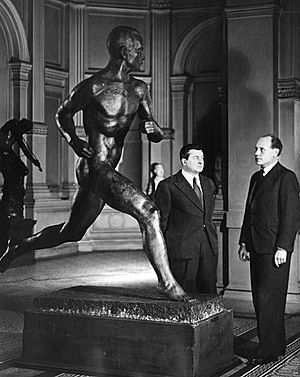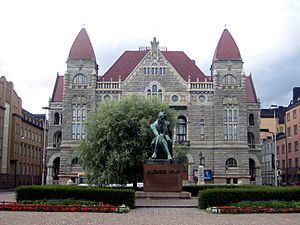Wäinö Aaltonen facts for kids
Quick facts for kids
Wäinö Aaltonen
|
|
|---|---|

Aaltonen in the early 20th century
|
|
| Born | March 8, 1894 Marttila, Finland
|
| Died | May 30, 1966 (aged 72) |
| Occupation | Sculptor |
| Years active | 1916–1961 |
|
Notable work
|
Paavo Nurmi statue, 1925 Aleksis Kivi Memorial, 1939 Statues in the plenary chamber of Parliament House |
| Spouse(s) | Aino Pietikäinen (m. 1920–19??) Elsa Rantalainen (m. 1931–19??) Elvi Hertell (m. 1942–19??) Elisabet Maasik (m. 1961–19??) |
Wäinö Valdemar Aaltonen (born March 8, 1894 – died May 30, 1966) was a very famous Finnish artist. He is known as one of the most important sculptors from Finland.
Contents
Early Life and Art Journey
Wäinö was born in a small village in Finland. He became deaf as a child. This led him to find his passion for art. When he was 16, he started studying at the School of Drawing of the Turku Art Association. He spent many years there learning to paint. However, he mostly taught himself how to sculpt. He learned how to work with marble from his relative, Aarre Aaltonen. He also worked as a trainee stonemason. A sculptor named Felix Nylund was a teacher at the art school for a short time. His work inspired young Wäinö.
Artistic Styles and Influences
In 1923, Aaltonen traveled to Italy. This trip introduced him to new art styles like Cubism and Futurism. Cubism uses geometric shapes to show objects from different angles. Futurism focuses on movement and speed. These new ideas mainly influenced his paintings.
Famous Sculptures and National Identity
As Finland became an independent country, Wäinö Aaltonen created sculptures to remember important events. He made many War Memorials. Soon, he became a national hero in Finland. His art often showed Finnish people and their spirit. He created large statues and busts (sculptures of a person's head and shoulders).
One of his most famous works is the 1925 statue of Paavo Nurmi. Nurmi was a famous Finnish runner. A copy of this statue is outside the Helsinki stadium. Another well-known work is a bust of the composer Jean Sibelius from 1928. Most of Aaltonen's sculptures were made from bronze. However, he also worked with stone and even glass. His art was mostly realistic, but you can still see hints of the Cubist style. He was also one of the first artists in the early 1900s to use "direct carving." This means carving directly into the material instead of making a model first.
Parliament House Sculptures
When the new Parliament House was being built in Finland, the architect wanted Aaltonen to create sculptures for it. Instead, there was a competition, and Aaltonen's work, called Work and the Future, won. He made a series of gilded (gold-covered) plaster sculptures in 1932. These were later cast in bronze after he passed away.
Personal Life and Legacy
Wäinö Aaltonen was married four times. His son, Matti Aaltonen, became an architect. Matti designed the Wäinö Aaltonen Museum in Turku.
Today, you can see many of Wäinö Aaltonen's sculptures at the Wäinö Aaltonen Museum of Art in Turku. His work was also part of the art competition at the 1948 Summer Olympics.
Notable Works
Wäinö Aaltonen created many important sculptures throughout his career. Here are some of his well-known pieces:
- The Boy in Granite, 1917–1920
- The Hero's Grave (Savonlinna war memorial), 1919–1921
- Paavo Nurmi runner statue, 1924–1925
- Musica, 1926
- Statues on Hämeensilta bridge in Tampere, 1927–1929. These include The Hunter, The Tax Collector, The Merchant, and The Maiden of Finland.
- Myrsky (a memorial for a sunken ship), 1930
- Statues in the plenary chamber of Parliament House, 1930–1932
- Aleksis Kivi Memorial in Helsinki, 1930–1939
- Marjatta, 1934
- Friendship is Forged (a joint monument for Turku and Gothenburg), 1948–1955
- Statues of presidents in front of Parliament House: K. J. Ståhlberg, 1957–1958; P. E. Svinhufvud, 1957–1959
See also
 In Spanish: Wäinö Aaltonen para niños
In Spanish: Wäinö Aaltonen para niños



